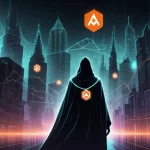BlockDAG’s $0.40 Price Prediction: Hype or 2025 Crypto Goldmine?

BlockDAG’s $0.40 Price Prediction: Game-Changer or Just Another Crypto Mirage?
Is BlockDAG (BDAG) the ultimate crypto gem for 2025 with its jaw-dropping $435 million presale and a projected price of $0.40, or are we falling for another overhyped promise? We’re putting this newcomer under the microscope alongside Polkadot (DOT), ZCash (ZEC), and Bittensor (TAO) to see which project truly holds the potential to disrupt the financial status quo—or just leave investors holding the bag.
- BlockDAG’s Bold Claim: $435M raised in presale at $0.005, targeting a post-launch $0.40 price.
- Competitors’ Challenges: Polkadot lags in adoption, ZCash rides volatile waves, and Bittensor’s entry price stings.
- Core Debate: Does BlockDAG’s data justify the hype, or are proven niches like privacy and interoperability safer bets?
BlockDAG: Presale Powerhouse or Hype Machine?
Let’s kick things off with BlockDAG, the shiny new contender that’s got the crypto crowd buzzing louder than a Bitcoin halving rally. Sitting in its 32nd presale batch at a mere $0.005 per token, this project has already raked in over $435 million—a figure that screams heavy institutional backing before it even hits public exchanges. With just 4.2 billion coins left unsold, scarcity is being weaponized to drive demand. The team projects a post-launch price of $0.40, which, if realized, translates to an 8,000% return for early birds. That’s the kind of number that makes even seasoned HODLers sit up straight. For deeper insights into why this projection is turning heads, check out this detailed analysis on BlockDAG’s potential.
What’s the tech behind this bold promise? BlockDAG uses a hybrid model combining Directed Acyclic Graph (DAG) and Proof-of-Work (PoW). In plain English, DAG lets multiple transactions process simultaneously, unlike traditional blockchains that queue them up one by one. This setup, paired with PoW’s security, delivers transaction speeds of up to 15,000 transactions per second (TPS). To put that in perspective, Bitcoin crawls at about 7 TPS, and Ethereum manages 15-30 on a good day. High TPS means a network can handle mass-scale payments or decentralized apps without grinding to a halt—a critical factor for real-world adoption.
But before we get too starry-eyed, let’s pump the brakes. Presale success doesn’t equal mainnet performance. History is littered with projects that dazzled early investors only to flop spectacularly—think BitConnect’s infamous collapse. Has BlockDAG’s 15,000 TPS been tested under real-world pressure, or is it just a shiny lab stat? Tokenomics—the economic model of how tokens are distributed, capped, and incentivized—look structured on paper, but until the network proves itself, this remains a high-stakes gamble. Still, for those who buy into effective accelerationism, BlockDAG’s potential to speed up decentralized finance could be a step toward shattering centralized payment monopolies—if it doesn’t implode first.
Polkadot: Interoperability Dream or Delayed Promise?
Next up is Polkadot, a veteran in the blockchain space with a mission to make different chains play nice together through interoperability. Trading around $3.20, DOT has endured wild price swings, mirroring the market’s uncertainty about its trajectory. The upcoming Polkadot 2.0 upgrades, including Elastic Scaling and the JAM protocol, aim to push throughput to an insane 500,000 to 1 million TPS. Elastic Scaling means developers can dynamically adjust resources for their apps, while JAM reimagines how data flows across chains. If delivered, this could redefine how decentralized networks operate, uniting fragmented ecosystems under one interoperable banner.
Yet, for all its developer buzz, Polkadot’s adoption rate is frustratingly sluggish. Why aren’t more projects flocking to its parachain system, which lets custom blockchains plug into Polkadot’s security? Regulatory uncertainties don’t help—potential ETF approvals or crackdowns could make or break DOT’s momentum. Compared to BlockDAG’s low-entry presale, Polkadot feels like a speculative bet tied to future milestones rather than immediate upside. That said, its vision of cross-chain harmony resonates deeply with the ethos of decentralization, challenging the siloed systems of traditional finance. But can it deliver before the market loses patience?
ZCash: Privacy Powerhouse with a Volatile Edge
Now, let’s talk ZCash, the privacy coin that’s recently skyrocketed past $700, fueled by a surging demand for on-chain anonymity. Built on a zero-knowledge security framework called zk-SNARKs, ZCash lets users hide transaction details—think of it as a digital cloak for your financial moves. In an age of government surveillance and looming central bank digital currencies (CBDCs), this feature isn’t just a gimmick; it’s a lifeline for freedom advocates. But here’s the kicker: that $700 price comes with volatility that could give even the toughest traders whiplash.
Privacy coins like ZCash occupy a vital but perilous niche. They’re often the first targets of regulatory crackdowns—look at the EU’s MiCA framework, which could impose strict rules on anonymous transactions, or past delistings of privacy tokens from major exchanges. One minute, ZCash is hailed as a bastion of liberty; the next, it’s a punching bag for lawmakers. While the need for privacy won’t vanish anytime soon, its price swings make it a speculative play rather than a stable hold. For investors eyeing 2025, ZCash offers a compelling use case but demands a stomach of steel.
Bittensor: Decentralized AI Vision with a Hefty Price Tag
Rounding out our lineup is Bittensor, trading at a steep $359 per token and carving a futuristic niche at the crossroads of decentralized AI and blockchain. This project rewards users for contributing to machine learning models, essentially crowdsourcing AI development on a transparent ledger. It’s a brilliant concept that’s caught the attention of institutional funds, signaling serious long-term potential. Imagine a world where AI isn’t monopolized by tech giants but democratized through decentralized networks—Bittensor embodies the spirit of effective accelerationism, pushing tech-driven societal shifts.
However, short-term, it’s a different story. Bittensor’s price sees sharp daily drops, and its high entry point locks out most retail investors. On top of that, the complexity of its ecosystem isn’t exactly welcoming to newcomers. While the marriage of AI and blockchain could redefine Web3, Bittensor feels like a “wait and see” investment compared to more accessible opportunities. Its volatility and niche focus make it a long play in a market often obsessed with quick flips.
Bitcoin’s Shadow: The King Still Reigns
As a Bitcoin maximalist at heart, I can’t ignore the elephant in the room: how do these altcoins stack up against Bitcoin’s unshakable status as a store of value? Bitcoin’s battle-tested security and decentralized ethos remain unmatched, processing value without bending to any central authority. BlockDAG’s speed dazzles, Polkadot’s interoperability inspires, ZCash’s privacy protects, and Bittensor’s AI innovates—but none carry Bitcoin’s proven resilience across market cycles. Altcoins fill critical niches, no doubt, but Bitcoin is the bedrock of this revolution. Any investment in these projects should be weighed against BTC’s steady, if slower, dominance. Why risk a presale flop when Bitcoin’s scars tell a story of survival?
The Bigger Picture: Hype vs. Substance in Crypto’s Wild Frontier
Stepping back, this comparison mirrors the broader crypto landscape—a chaotic battleground of innovation, speculation, and outright scams. BlockDAG’s presale haul taps into the allure of early-stage gains, reminiscent of the 2017 ICO mania or the 2020 DeFi boom. But history warns us: not every hot presale becomes a sustainable force. Look at the countless projects that raised millions only to vanish, leaving investors burned. Polkadot and ZCash address fundamental needs—cross-chain compatibility and privacy—while Bittensor bets on a future where AI and blockchain converge. Each aligns with the mission of disrupting centralized systems, yet each carries baggage, from adoption hurdles to regulatory landmines.
So why does BlockDAG stand out as the so-called top crypto to buy for 2025? Its structured presale offers a low entry at $0.005 with clear tokenomics, contrasting the higher volatility or steeper barriers of Polkadot, ZCash, and Bittensor. That $0.40 projection isn’t just a random figure—it’s tied to supply constraints and institutional interest. But let’s be brutally honest: presales are a notorious playground for overpromising. We’ve seen this movie before—pump the hype, dump on retail investors, and leave them with worthless tokens. BlockDAG’s hybrid DAG/PoW model sounds cutting-edge, but it’s untested at scale. Meanwhile, Polkadot and ZCash offer battle-worn use cases, even if their immediate upside pales in comparison. Bittensor’s vision excites, but it’s a distant horizon.
Let’s not forget the elephant in the room: sponsored narratives can skew perception. Some analyses of BlockDAG come with disclaimers hinting at paid promotion, a red flag in an industry already rife with shills. Crypto isn’t a get-rich-quick scheme, and every project here could tank tomorrow. Invest only what you’re willing to lose, and don’t swallow bold claims without chewing on the risks first.
Key Takeaways and Critical Questions for Crypto Investors
- What’s fueling BlockDAG’s hype as a top crypto investment for 2025?
Its $435 million presale, dirt-cheap $0.005 entry price, projected $0.40 target, and 15,000 TPS capability position it as an early-stage bet with massive potential returns—if the tech holds up. - Can Polkadot overcome its adoption struggles with upcoming upgrades?
Polkadot 2.0 promises game-changing scalability at 500K–1M TPS, but slow adoption and regulatory uncertainty could stall its price momentum and broader impact. - Is ZCash’s $700 price surge a sustainable trend for privacy coins?
Rising demand for anonymity drives its value, but extreme volatility and regulatory risks make it more of a speculative gamble than a reliable hold. - Does Bittensor’s decentralized AI focus justify its $359 cost?
Its innovative vision and institutional backing hint at long-term promise, but high entry barriers and market swings limit its near-term appeal for most investors. - How should investors approach bold crypto price predictions like BlockDAG’s?
View them with heavy skepticism, dig into the tech and tokenomics, and brace for the very real chance that presale hype overshadows delivery. Do your own damn research. - Where does Bitcoin fit in amid altcoin innovation?
Bitcoin remains the safest bet for store-of-value purists, outlasting fads with unmatched security, even if altcoins like these carve out vital niches with flashier promises.
Here’s the raw truth: BlockDAG’s numbers are seductive, dangling the carrot of explosive gains for early investors. Its potential to accelerate decentralized tech aligns with the push for a freer, faster financial future. But crypto is a minefield—one wrong step, and your portfolio blows up. Polkadot, ZCash, and Bittensor each bring unique strengths to the table, fueling the broader mission of decentralization and innovation. As someone who cheers for Bitcoin’s reign while respecting altcoin experiments, I’m rooting for projects that challenge the old guard—but not blindly. Question every claim, ignore the shills, and tread carefully. The data might speak, but only critical minds will hear it right.



